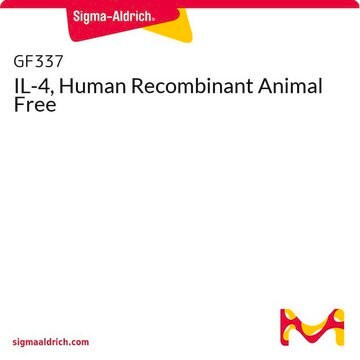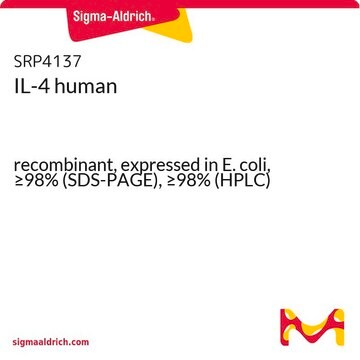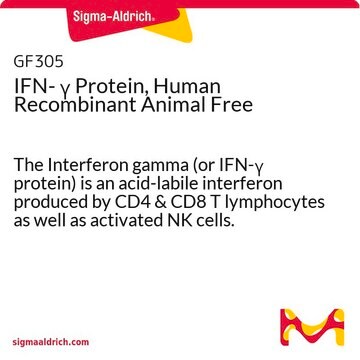SRP3274
IL-13 human
Animal-component free, recombinant, expressed in E. coli, ≥98% (SDS-PAGE), ≥98% (HPLC)
Sinónimos:
NC300
Iniciar sesiónpara Ver la Fijación de precios por contrato y de la organización
About This Item
UNSPSC Code:
12352202
NACRES:
NA.32
Productos recomendados
biological source
human
recombinant
expressed in E. coli
assay
≥98% (HPLC)
≥98% (SDS-PAGE)
form
lyophilized
potency
≥1.0 ng/mL
mol wt
12.6 kDa
packaging
pkg of 10 μg
impurities
<0.1 EU/μg endotoxin, tested
color
white to off-white
UniProt accession no.
shipped in
wet ice
storage temp.
−20°C
Gene Information
human ... IL13(3596)
General description
Interleukin-13 (IL-13) is an immunoregulatory cytokine produced primarily by activated T-helper 2 (Th2) cells,and also by mast cells and natural killer (NK) cells. The gene encoding it is localized on human chromosome 5q31. Human and murine IL-13 is cross-species reactive. Recombinant human IL-13 is a 12.6kDa protein consisting of 115 amino acid residues.
Biochem/physiol Actions
Interleukin-13 (IL-13) has a role in immune activities against infections and influences the function of various cells taking part in the same. It has been studied to be overexpressed in glioblastoma tumors and cell lines. IL-13 stimulates fibrosis in many infectious diseases. Targeted deletion of IL-13 in mice resulted in impaired T-helper 2 (Th2) cell development and indicated an important role for IL-13 in the expulsion of gastrointestinal parasites. IL-13 exerts anti-inflammatory effects on monocytes and macrophages and it inhibits the expression of inflammatory cytokines such as tumor necrosis factor-α (TNF-α), interleukins-1β, -6 and -8. IL-13 has also been shown to enhance B cell proliferation and to induce isotype switching resulting in increased production of immunoglobulin E (IgE). Blocking of IL-13 activity inhibits the pathophysiology of asthma.
Physical form
Lyophilized from 20mM Sodium Phosphate, pH 7.0.
Reconstitution
Centrifuge the vial prior to opening. Reconstitute in water to a concentration of 0.1-1.0 mg/mL. Note: Slow to dissolve. Do not vortex. This solution can be stored at 2-8°C for up to 1 week. For extended storage, it is recommended to further dilute in a buffer containing a carrier protein (example 0.1% BSA) and store in working aliquots at -20°C to -80°C.
Storage Class
10 - Combustible liquids
wgk_germany
WGK 3
flash_point_f
Not applicable
flash_point_c
Not applicable
Certificados de análisis (COA)
Busque Certificados de análisis (COA) introduciendo el número de lote del producto. Los números de lote se encuentran en la etiqueta del producto después de las palabras «Lot» o «Batch»
¿Ya tiene este producto?
Encuentre la documentación para los productos que ha comprado recientemente en la Biblioteca de documentos.
Genetic variants of IL-13 signalling and human asthma and atopy.
Heinzmann A
Human Molecular Genetics, 9(4), 549-559 (2000)
Ji-Yun Lee et al.
Journal of immunology (Baltimore, Md. : 1950), 194(12), 5990-5998 (2015-05-15)
Mucin overproduction is a hallmark of otitis media (OM). Streptococcus pneumoniae is one of the most common bacterial pathogens causing OM. Mucin MUC5AC plays an important role in mucociliary clearance of bacterial pathogens. However, if uncontrolled, excessive mucus contributes significantly
M Wills-Karp et al.
Science (New York, N.Y.), 282(5397), 2258-2261 (1998-12-18)
The worldwide incidence, morbidity, and mortality of allergic asthma are increasing. The pathophysiological features of allergic asthma are thought to result from the aberrant expansion of CD4(+) T cells producing the type 2 cytokines interleukin-4 (IL-4) and IL-5, although a
IL-13 induces proliferation, Ig isotype switching, and Ig synthesis by immature human fetal B cells.
Punnonen J and de Vries JE
Journal of Immunology, 152(3), 1094-1102 (1994)
IL-4, IL-10 and IL-13 down-regulate monocyte-chemoattracting protein-1 (MCP-1) production in activated intestinal epithelial cells.
Kucharzik T
Clinical and Experimental Immunology, 111(1), 152-157 (1998)
Nuestro equipo de científicos tiene experiencia en todas las áreas de investigación: Ciencias de la vida, Ciencia de los materiales, Síntesis química, Cromatografía, Analítica y muchas otras.
Póngase en contacto con el Servicio técnico






